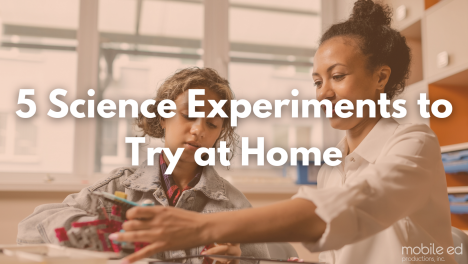
5 Easy Science Experiments to Try at Home
Getting students excited to learn can start at home! Science experiments are a great way to learn about the world around us while having a lot of fun. You can conduct experiments at home and learn something new with a few simple materials. We'll explore some fun science experiments you can try at home.
These five science experiments are fun and easy to perform at home, and they can help you learn some scientific concepts while having fun. You can create a lava lamp with oil, water, food coloring, and an Alka-Seltzer tablet; simulate a solar eclipse with a flashlight, a ball or globe, and a small object; make an egg bouncy with vinegar and a raw egg; create a volcano with baking soda, vinegar, and red food coloring; and make magic milk with milk, food coloring, and dish soap. These experiments are perfect for kids and adults alike, and they can be a great way to spend time together while learning something new.
- Lava Lamp
A lava lamp is a classic experiment that many of us have tried at least once. You can make your own lava lamp at home with some simple ingredients. Here's how to do it:
Materials:
- An empty plastic bottle
- Vegetable oil
- Water
- Food coloring
- Alka-Seltzer tablets
Instructions:
- Fill the plastic bottle with 3/4th vegetable oil and 1/4th water.
- Add 10-15 drops of food coloring to the bottle.
- Break an Alka-Seltzer tablet into small pieces.
- Drop one piece of the tablet into the bottle and watch the magic happen!
You will see the colored water droplets rising and falling in the oil, creating a lava lamp effect. The Alka-Seltzer tablet reacts with the water, producing carbon dioxide gas bubbles that carry the water to the surface. As the gas escapes, the water droplets sink back down to the bottom.
- Solar Eclipse
A solar eclipse is a rare and fascinating event that occurs when the Moon passes between the Earth and the sun, casting a shadow on the Earth's surface. You can simulate a solar eclipse at home with a few household items.
Materials:
- A flashlight
- A ball or a globe
- A small object like a toy car or a pen
Instructions:
- Turn off the lights in the room.
- Place the ball or globe on a table or the floor.
- Hold the flashlight at an angle above the ball, shining the light on one side of it. 4. Place the tiny object on the opposite side of the ball from the flashlight so that it casts a shadow on the ball.
- Move the object around the ball to simulate the Moon passing in front of the Sun and casting a shadow on the Earth.
You will see the object's shadow moving across the ball's surface, simulating a solar eclipse.
- Bouncy Egg
Did you know that you can make an egg bouncy? The eggshell is made of calcium carbonate, which reacts with vinegar to produce carbon dioxide gas. This reaction can dissolve the eggshell, leaving a naked egg that can bounce!
Materials:
- A raw egg
- White vinegar
- A clear glass or jar
Instructions:
- Place the egg in a glass or jar.
- Pour enough vinegar over the egg to cover it completely.
- Wait 24-48 hours for the reaction to take place.
- Carefully remove the egg from the vinegar and rinse it gently with water.
- Test the bounce of the egg by dropping it from a low height.
You will see that the naked egg bounces, thanks to the removal of the eggshell. The vinegar reacts with the calcium carbonate in the eggshell, producing carbon dioxide gas that dissolves the shell and leaves the egg membrane intact.
- Volcano
Making a volcano is a classic chemistry experiment kids have loved for generations. Here's how you can make your own volcano at home:
Materials:
- A tall glass or plastic bottle
- Baking soda
- Vinegar
- Food coloring
- Dish soap
- Water
- Tray or container to catch the eruption
Instructions:
- Fill the bottle about 1/3 full with warm water.
- Add several drops of food coloring and a squirt of dish soap to the water and mix.
- Add a spoonful of baking soda to the bottle.
- Slowly pour vinegar into the bottle until the mixture erupts like a volcano.
- Repeat the experiment several times to see how different amounts of baking soda and vinegar affect the eruption.
- Magic Milk
This science experiment is a fun way to teach kids about surface tension and how different substances react when mixed. Here's how to do it:
Materials:
- A shallow dish
- Whole milk
- Food coloring
- Dish soap
Instructions:
- Pour a thin layer of milk into the dish.
- Add several drops of food coloring to the milk.
- Dip a cotton swab in dish soap.
- Touch the dish soap to the milk and watch the colors move and swirl.
- Repeat the experiment with different colors and different amounts of dish soap to see how the patterns change.
Mobile Ed loves getting students excited to learn! We’ve found that science experiments are one of the best ways to engage our students, provide hands-on learning experiences, and help students apply school lessons to their everyday life. Mobile Ed’s science programs sell out each year because students enjoy experiencing science in unique and exciting ways.
Learn more about Mobile Ed’s bestselling
science programs here.
Contributed by Taylor Thompson, a Digital PR Specialist for Eclipse Glasses.






